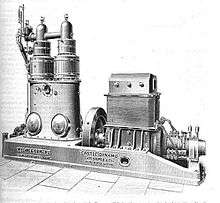John Henry Holmes
John Henry Holmes (1857-1935) was an English electrical engineer, inventor, Quaker and pioneer of electric lighting who invented the quick break light switch, the technology behind which remains the basis for modern wall mounted light switches.[1]
John Henry Holmes | |
|---|---|
| Born | 1857 |
| Died | 1935 |
| Nationality | English |
| Occupation | Electrical Engineer, Inventor |
| Employer | J. H. Holmes & Co. |
| Known for | Developing technology behind the modern light switch |
Career

In 1880, Holmes attended a public demonstration of Joseph Swan's incandescent light bulb. This seemed to spark his interest in electric lighting, and he approached Swan on multiple occasions in hopes of becoming his apprentice.[2]
John Henry Holmes and his brother Theodore, also a Quaker, founded J. H. Holmes & Co. in Shieldfield, Newcastle upon Tyne in 1883, their manufacturing company specializing in early motors, dynamos,[3][4][5] switches, and lighting. The company was very active in the early proliferation of electric lighting, having installed Newcastle's first domestic electrical lighting into their father's house, and supplied installations throughout Europe and the British colonies,[6] making deals in the United States as well.[7]
John Henry Holmes invented the quick break light switch in 1884.[8] which was patented in Great Britain [9] and the United States [10] that year. The technology radically improved the prior switch technology by ensuring the internal contacts moved apart quickly enough to deter the electric arcing that would create a fire hazard and otherwise invariably shorten the switch's lifespan.[11] The quick break technology invented by Holmes remains in use in billions of domestic and industrial electrical switches across the globe to this day.
References
- "View GNG Item - Great North Run Culture". www.greatnorthgreats.com. Archived from the original on 15 August 2016. Retrieved 18 May 2016.
- Clayson, John; Maggs, Katie (7 June 2013). "What's in store: how First Time Out opened our eyes to new possibilities". the Guardian. Retrieved 19 May 2016.
- "New Catalogues and Trade Publications". The Engineering Magazine. An Industrial Review. 14: 910. 1898. Retrieved 18 May 2016.
- "H6579 Recording voltmeter, J H Holmes & Co, Newcastle-on-Tyne, UK". www.powerhousemuseum.com. Retrieved 19 May 2016.
- "J. H. Holmes and Co". www.gracesguide.co.uk. Retrieved 19 May 2016.
- "The Progress of Electrical Engineering in 1889". Industries and Iron. 8: 49. 17 January 1890.
- "Special Correspondence". Electrical World. 29. 20 April 1897. Retrieved 18 May 2016.
- "Electric light in North East England". www.englandsnortheast.co.uk. Retrieved 19 May 2016.
- "GB Patent No. 3256 of 1884: 'Improvements in or Applicable to Switches or Circuit Closers for Electrical Conducting Apparatus'". European Patent Office/. Her Majesty's Stationery Office. 29 September 1884. Retrieved 3 September 2017.
- "US Patent No. 305310 of 1884: 'Electric Circuit Closer'". United States Patent and Trade Mark Office/. 16 September 1884. Retrieved 3 September 2017.
- "The Classic Light Switch, Redefined". Professional Design. 24 January 2017. Retrieved 14 April 2018.